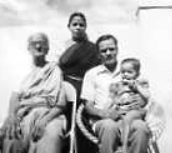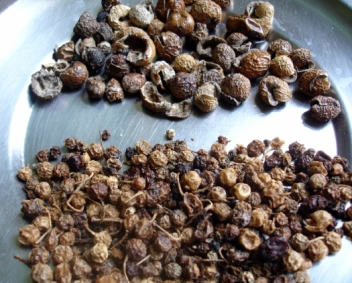Latest Contributions
Vathal Kulambu
Category:
Vegetarian, spicy, main dish, Tamilian, medicinal, unusual

I was born and brought up in a traditional Telugu Brahmin family in Tamilnadu. I did my Masters in IT, and am currently settled in USA. Cooking and entertaining are my passions. I want to share my recipes, so I have created http://neivedyam.blogspot.com:80/. Husband Venkat is a busy IT person and my best critic. I am a busy mom of two adorable kids, but do find time for my other hobbies: music, photography, travelling, gardening and cookbooks.
My memories still wander around my Nanamma's (father's mother in Telugu) lovely home, where her kitchen opened into a beautiful wide backyard with Tulasi madam (place where Tulasi plant is worshiped), hibiscus plants, and coconut trees. In 1990's I spent most of my childhood at my grandmother's.

My Nanamma's home was always busy with guests and relatives. She never used to get tired cooking for a large crowd. She was filled with energy and her kitchen was a lovely place to sit and have long chats. I come from a Telugu Brahmin family settled in Tamilnadu, so my Nanamma was an expert in both Telugu and Tamilian cuisine. Being a very strict and principled person, my Nanamma never allowed anyone inside her kitchen without completing the morning rituals such as bathing, praying, etc. Early in the morning, my cousins and I used to wait for her famous filter coffee, which would mesmerize the whole house with its aroma.
I learnt this authentic Tamilian recipe by watching my Nanamma in her kitchen. Nobody could make it as tasty as her.

Not many people make this traditional, medicinal curry these days.
Serves: 4
Preparation time: 15 minutes
Cooking time: 30 minutes
Ingredients
- Sundakkai (Turkey berry) or manathakali vathal (black nightshade) - 0.5 cup
Sundakkai's scientific name is Canthium inerme\; Manathakkali vathal is Solanum nigrum.

They are prepared by soaking them in sour yoghurt and salt. Later they are sun dried till crisp and dry. Manathakkali is high in vitamins and has many medicinal properties. It is used as a cardiac tonic. It corrects disorders of nutrition. The fruit of the plant serves as an effective laxative and improves appetite. Sundakkai is good for skin ailments and liver disorders. It has the medicinal values for increasing the appetite and relieves colds. Root and leaves are used for waist cramp, traumatic injury and gastric pain, and as antitussive, amenorrhea and analgesic. It is also good for chronic coughs.
If you don't have manathakkali vathal, you can use fried bitter gourd or okra.
- Medium sliced onions - 1 cup
- Tomato puree - 1 cup
- Thick Tamarind puree - 1 cup (from a big lemon size tamarind)
- Turmeric powder - 1 tsp
- Jaggery or cane sugar- 2 tbsp
- Water - 0.5 cup
- Oil - 3-4 tbsp
- Vathal kulambu powder - 2 tsp
- Salt to taste
For Tempering
- Mustard seeds - 0.33 tsp
- Fenugreek Seeds 0.33 tsp
- Red chillies- 3-4
- Curry leaves- a handful
- Asafoetida- 0.33 tsp
To make vathal kulambu powder, if needed.
- Coriander seeds - 1 tsp
- Red gram dal (thoor dal) - 2 tsp
- Gram dal (chana dal) - 2 tsp
- Cumin seed - 1 tsp
- Sesame seed - 1tsp
- Roasted gram dal (pottu kadalai in Tamil) - 2 tsp
- Red dry chillies - 4-5
- Asafoetida - 0.5 tsp
Method
Vathal kulambu powder
Roast each ingredient separately in medium heat. When you roast the dals, make sure that you roast them until they give out their distinctive aroma.
After cooling, grind them all together into a powder.
You can increase the amount you make, maintaining the proportions, and store the power.
Vathal kulambu
In a deep bottom frying pan, add 2-3 tbsp oil and fry the manathakali vathal till aroma rises. Remove it from the pan and keep separately.
In the same pan fry onions and add tamarind puree, tomato puree, vathal kulambu powder, salt, turmeric, and water, and bring to boil.
Once it has come to a good boil, add the vathal you had set aside, also add jaggery and cook for 3-5 minutes.
Temper this curry with mustard, fenugreek seeds, curry leaves, red chillies and asafoetida.
© Sharmila Venkat 2009
Comments
Add new comment